How to choose the best gas boiler: an overview of the criteria for choosing the best unit
Are you going to buy an efficient gas boiler that can provide heat in the most severe frosts? When choosing equipment for the home, many factors have to be taken into account. Which is the best option? What are the most important criteria? The owners of private houses and apartments have to think about solving this problem.
Agree, it’s a shame to pay twice and ultimately get an insufficiently functional boiler that is not able to heat a country house with the onset of cold weather. Therefore, before choosing a gas boiler in the store, you have to weigh the pros and cons. Otherwise, you can take a far from suitable model.
We will help you determine the main criteria that radically affect your choice. Useful recommendations and important nuances are outlined in our article. To help the homeowner, photographs and a selection of videos with the advice of experienced experts in the field of heat supply are given.
The content of the article:
The main nuances of choosing a gas boiler
The absence or constant interruptions of centralized heating and hot water supply force the owners of cottages and city apartments to create own autonomous systems.
Their main element is a boiler, which, by burning fuel, heats the heat carrier for the heating system and water for domestic use.
The choice in favor of gas equipment is due to the economical use of gas as fuel. All other options for combustible fuel are more expensive or produce less heat at times.
Plus, modern heaters of this type do not require constant supervision. I connected the installation to the main pipe or cylinder, and it works without interruption while there is something to burn.
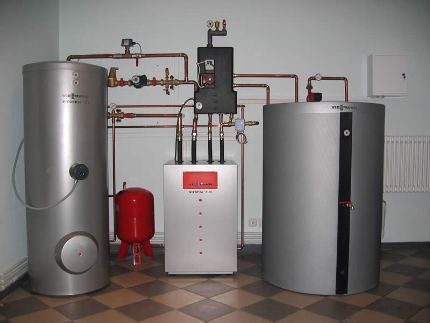
However, in order for the gas boiler to function properly and in the optimal mode, it is necessary to correctly select it upon purchase and regularly maintain it after connection.
There are many different functional and special modules within the models of this equipment. The purchase of a gas-fired heating unit should be approached thoughtfully.
There are many criteria for choosing a gas boiler, but the main ones are:
- Power delivered by the device.
- Layout solution (number of circuits, housing type and heat exchanger material).
- Place to install.
- Availability of automation for safe operation.
All these issues are closely related. The lack of space for a large unit or the desire to mount a device with an aesthetic appearance in the kitchen forces us to choose a wall model of lower power than the floor version. And the need to heat hot water for the washbasin and shower makes you look for a boiler with two circuits.

Subtleties of choosing a boiler for heating and hot water
Modern heating equipment has a stylish appearance, is filled with all kinds of sensors and can work in several modes.
However, a promoted or widely advertised gas boiler does not mean - the best and best. When choosing, you should focus not only on its design, but on functionality.

First, the gas in the burner is ignited using an electronic system or a piezoelectric element. Then, as a result of its combustion, water is heated in the furnace by means of a heat exchanger, which is sent to the heating system circuit.
This is how classic single-loop models work. To prepare hot sanitary water, you must choose dual circuit installation or connect a boiler.
Criterion # 1 - material and heat exchanger design
The selection of an internal heat exchanger must be approached with particular attention. Water moves inside it, and quite powerful and high-temperature flow of thermal energy acts outside.
On the one hand, the material of its manufacture must be very durable, and on the other, heat-conducting. The more it transfers the heat generated by the combustion of gas coolant, the higher the efficiency of the installation.
Manufacturers equip gas boilers with heat exchangers from:
- cast iron;
- of stainless steel;
- copper.
Due to the lack of a predisposition to corrosion from contact with water, the cast iron version is the most durable. But he has quite a lot of weight. And with improper use, it can burst at the border between areas with very different temperatures. To prevent this, you will have to rinse it more often.
Steel heat exchanger is the most common. It is cheaper than cast iron and copper counterparts. Plus, this metal has good ductility, which reduces the likelihood of cracks. However, steel in the heating circuit corrodes quickly.
Copper is more resistant to corrosive processes and has better heat transfer characteristics. The heat exchanger from it is light in weight and compact in size. But this option costs a lot of money.

According to the internal design, the heat exchange coil can be ordinary and bithermal. The first involves connecting only one water circuit, and the second at the same time two. Double-circuit boilers are equipped with a pair of conventional heat exchangers or one bithermal. The second option is cheaper.
Criterion # 2 - type of unit location
Gas boilers are installed on the floor or suspended on the wall. Models of the first type are called floor models and are characterized by large dimensions. Most often they have cast-iron or steel heat exchangers. These options have better performance in terms of the price of equipment / power than wall-mounted counterparts.
The main minus floor boilers - a lot of weight. But if you need a powerful unit, then you can not do without equipment installed on the floor. Mounted floor-mounted modifications are much inferior in power.
The choice here depends on your needs. For a private house of large quadrature, a powerful model is required, and for a city apartment a more compact and less productive device will be enough.
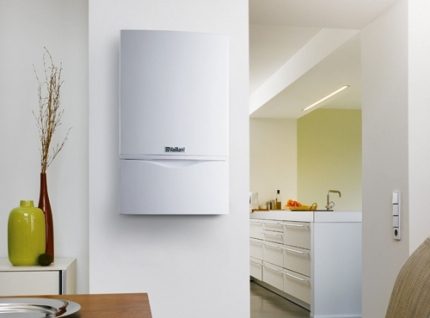
Unlike floor models, many of which can function without being connected to electricity, almost all mounted boilers are volatile.
The latter are effective, comfortable in operation and are pleased with advanced features in terms of customization. But when there is a power outage, there is no sense in them, in the event of a power outage, heat will also disappear with the light.
For a country house, it is best to take a non-volatile floor boiler with mechanical control. He is simple in installation and connection, it does not have programmable thermostats and displays, but it will generate heat even if the cottage is completely disconnected from the power supply. And the service life of equipment installed on the floor is higher than that of a wall competitor.
Criterion # 3 - the number of circuits
For the organization in the home of pure heating, the best option for a gas boiler is a single-circuit model. The same applies to a situation where only a heater is needed to supply hot water to the faucet above the sink.
If it is planned to connect the pipes of the heating system and / or underfloor heating, as well as the hot water supply to the gas heating unit, then it must have two or more circuits.
A connection option is also possible. indirect heating boiler. In this case, a pipe is diverted from a single-circuit boiler to a tank with heated water. Technically similar schemes are allowed, but the only heat exchanger will work with increased load.
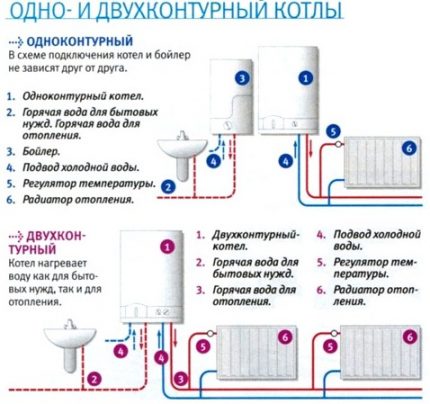
Most of the dual-circuit units are heated with hot water for domestic use through a continuous process, which is not very economical. It is better to install a remote boiler tank or choose a gas boiler with a built-in large volume water heater.
Both options will allow you to heat up to one cubic meter of water and maintain its high temperature for a long time. Single-circuit heaters are ideal for apartments, summer residences with non-permanent residence and cottages where a family of two to three people lives.
For a private house with several floors, with a heated pool or floor heating system it is best to choose a dual-circuit gas boiler.
Criterion # 4 - combustion chamber, type of ignition and burner
To maintain the process of burning gas in the boiler, oxygen is needed. He can get into the furnace from the room or from the street. In the first case, the heater is equipped with an atmospheric burner of natural air flow, and in the second case, it is closed with forced injection thereof.
Accordingly, two types of combustion chambers are distinguished:
- Open - oxygen to maintain the flame is taken directly from the room with heating equipment.
- Closed - air for burning gas is sucked into the furnace from the street by means of a coaxial chimney or additional ventilation pipe.
In order to correctly determine which gas boiler is better - with a closed chamber and a turbo burner or with an open firebox and an atmospheric burner, you need to clearly understand that the second option will require a chimney five to six meters high to provide natural draft.
However, it is not always possible to bring such a high pipe to the roof.
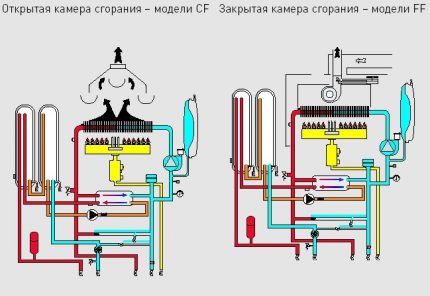
To heat an apartment in an urban high-rise building, it is better to buy a gas boiler with an air supercharger and coaxial chimney flue. It has higher efficiency and is easier to mount. But it is volatile, a fan without voltage in the mains will not work.
Therefore, in order not to be left without heat at some point, it is worth taking care of an uninterruptible power supply or a backup electric generator.
An open-chamber heater is recommended to be installed outside the living area. An extension or a boiler room in the basement is best suited for this purpose. In this case, additional attention must be paid to the quality of ventilation in this room.
In some cases, you will even have to do forced ventilation, otherwise oxygen may not be enough to efficiently burn natural gas.
On the one hand, the closed version has a higher efficiency and does not burn oxygen in the room, but on the other hand, such boilers are more expensive and depend on electricity. Without the latter, the gas heater with electric ignition will stop working.
If there are problems with the uninterrupted supply of electricity, it is better to prefer equipment with piezo ignition, which does not require electricity for operation by definition.
Criterion # 5 - automation, adjustment and diagnostics
To simplify your life, when choosing a gas boiler, special attention should be paid to it “Electronic stuffing”. Manufacturers offer a lot of additional options that greatly facilitate the operation of heating equipment on gas.
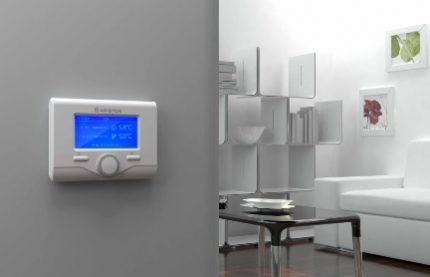
Power adjustment can be:
- single stage;
- two-stage;
- Smooth with flame modulation.
The simplest and cheapest option is a single-stage with one ON / OFF button. The power of the boiler in this case is practically not regulated. The burner in it either works or is turned off.
Models with two-stage adjustment suggest a pair of operating modes with different power.
From this point of view, the best gas boilers are considered units with a modulator, which allows you to smoothly control the intensity of fuel combustion. Automation, depending on the water flow rate and the temperature set by the owner, independently turns on the required number of burners and adjusts the height of their flame.
To ensure safety, the heaters are equipped with:
- pressure monitoring sensors in the gas line, expansion tank and circuits with pumped water;
- flame attenuation sensors;
- self-locking system for various emergency situations (fires, smoke, power outages);
- pressure relief valves;
- water purification filters;
- overheating thermostats.
All this automation allows you to protect the heating equipment from damage in case of emergency, as well as maximize its efficiency.
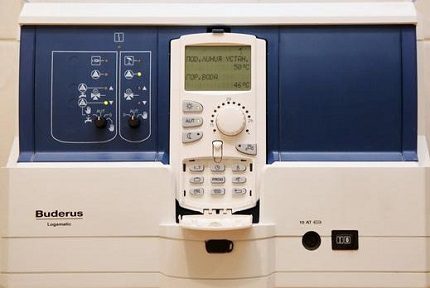
You can configure the boiler so that it, in the absence of people in the house, operates at a minimum cost, and half an hour before the owners arrive, it raises the room temperature to more comfortable indicators.
What capacity should the boiler be?
The technical documentation for the gas heater necessarily contains information about the rated power. Before buying equipment, it is advisable calculate the room's heat demand. Often the manufacturer there indicates the quadrature of the room, which this equipment will be able to heat.
But all this is rather arbitrary, without competent thermal engineering calculations of a particular house, it is not worth choosing a gas boiler.
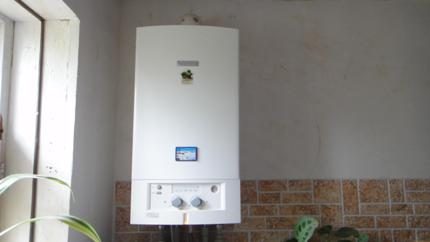
Recommendations about 1 kW per 10 m2 cottages are very average indicators. They rarely reflect reality.
An experienced heat engineer in the calculations should take into account:
- the area and cubic capacity of each room;
- climatic conditions of the region of residence;
- quality of insulation of external walls;
- the size and number of windows, as well as the type of glass in them;
- the presence of balconies and street doors;
- characteristics of the heating system, etc.
In addition, fuel quality and gas pressure in the line are taken into account. A separate calculation is made for the domestic hot water system. And only then both numbers are summed up and increased by 15–20% in reserve so that the boiler can cope with both constant and peak load without any problems.
Conclusions and useful video on the topic
Video # 1.How to correctly choose a gas boiler:
Video # 2. How to choose a gas-type heater based on the declared power:
Video # 3. What is the best choice for a cottage floor boiler:
It is essentially impossible to give unequivocal advice on which gas boiler is better to buy. The heater for domestic hot water and the heating system for each specific home must be selected individually. And this should be done only on the basis of calculations by a competent heating engineer, taking into account all the nuances.
The criteria and subtleties in choosing a boiler mass. Before you go to the store, you should carefully study everything, but it is better to consult a specialist in this field.
Do you want to share useful tips in the selection and purchase of a gas boiler? Have your own thoughts and experience in operating the unit? Did you find any flaws in the material presented for familiarization? Please write comments in the block below the text. Communication will help to quickly clarify difficult points.

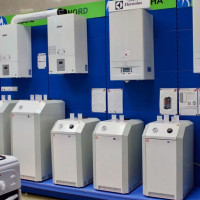 Wall or floor gas boiler - which is better? Arguments for choosing the best equipment
Wall or floor gas boiler - which is better? Arguments for choosing the best equipment 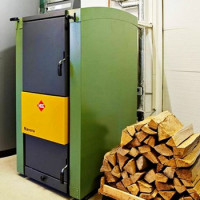 Solid fuel boilers: main types and criteria for choosing the best unit
Solid fuel boilers: main types and criteria for choosing the best unit  Which is better and more profitable - a gas or electric boiler? Arguments for choosing the most practical option
Which is better and more profitable - a gas or electric boiler? Arguments for choosing the most practical option 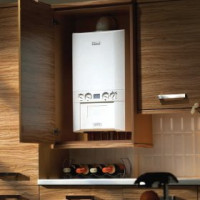 How to choose a gas wall-mounted double-circuit boiler: what to look at + what the market offers
How to choose a gas wall-mounted double-circuit boiler: what to look at + what the market offers 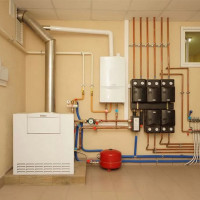 Atmospheric or turbocharged gas boiler - which is better to choose? Weighted Purchase Criteria
Atmospheric or turbocharged gas boiler - which is better to choose? Weighted Purchase Criteria 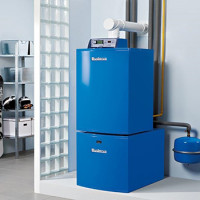 How to choose a dual-circuit floor gas boiler: what to look at before buying?
How to choose a dual-circuit floor gas boiler: what to look at before buying?  How much does it cost to connect gas to a private house: the price of organizing gas supply
How much does it cost to connect gas to a private house: the price of organizing gas supply  The best washing machines with dryer: model rating and customer tips
The best washing machines with dryer: model rating and customer tips  What is the color temperature of light and the nuances of choosing the temperature of the lamps to suit your needs
What is the color temperature of light and the nuances of choosing the temperature of the lamps to suit your needs  Replacement of a geyser in an apartment: replacement paperwork + basic norms and requirements
Replacement of a geyser in an apartment: replacement paperwork + basic norms and requirements
Personal opinion (if you live in a region with a cool climate), take a little extra power. Once I needed to heat a large basement for business purposes (almost a hangar). The peculiarity is that the temperature had to be maintained constantly the same. They were greedy, counted back to back - and as a result, they almost got on the money. Therefore, pay particular attention to the climate of your region, and also to the features of the structure. And it is better to consult with professionals.
In principle, this is how I chose a boiler. I agree, we must take power with a margin. I took almost 2 times the supply, because this is my house and in the future I will finish building it: either expand or build on the second floor. About the contours. I took 2 circuits. This really saves money. The contours are independent, they work with a bang. And also I recommend that after choosing a boiler, call for service and clarify if there are problems with this model, or it works without complaints.
The big problem with the connection: wait for gasification for two years or consider alternative heating options: pallets, firewood, electricity?
And that's up to you. Each boiler has its own nuances. Of course, gas is cheaper to operate, but MUCH more expensive to install and connect compared to other options. I already had a site with gas, so, in general, I did not think about the choice. But his father was built in a village where he simply does not exist, he has a pelletnik. He is satisfied and does not think of switching to gas. My advice is to rummage through the forums, if pellets can be obtained without problems in your region, then this boiler will be the most economical. My father has Dozatech - a boiler (Russian), good, for heating 100 squares, plus a hot water heating circuit is also connected. If set, then this, probably. At least, its efficiency is close to the parameters of a gas boiler (of course, if you make the piping correctly). And a heat exchanger for five highways. This is a lot, basically all three-line boilers go, and this is heat loss.
In your case, the optimal solution would be to purchase a combined boiler.I think the best thing would be a combined electricity / gas boiler. This is exactly the option when you can say that you kill two birds with one stone.
You are installing a boiler that will heat your home before connecting the gas. All piping, piping, radiators - all of this will already be ready for the use of heating with gas. That is, this is a universal solution: after connecting the gas you do not need to redo anything in essence - this is the charm of using a combined boiler.
If you consider the alternatives, then later on you will have to redo the piping, pipes, etc. for gas. The issue price is about $ 500 for a combined boiler and higher. For example, ATEM Zhytomyr 10СНВ / КЕ-4,5, which can simultaneously operate on two types of energy, as well as separately, of course.
Once, this question was also acute for us and the heating system was calculated in such a way that after installing the electric boiler, we can connect a gas one at any time and it will also work efficiently on the already installed pipe reamer. But the option proposed by Alexei below, I personally like more.
As for the electric boiler, not everyone will do that. For heating 43 squares, a connection of 2 kW is enough. This is 48 kW per day and 1440 kW per month. If you take the tariff of our city - 4896 rubles per month for heating alone. Saved only 30% subsidy for utilities as a large.
Listen, now there are no problems with pellets at all. But do not find sawdust on any sawmill. Everything goes either to them, or to cat's filler) We have the whole village either on electric boilers or on pellets. The only negative is that you need a room to store them. And the rest is a fairly economical and simple option.
In any boiler, cons can be found, and in any form of heating. For me, the peletnik is the second most convenient and economical after natural gas. Of course, I did not specifically compare, but I drown not much more expensive than in the neighboring village with gas. Naturally, a lot depends on the boiler and the correct piping. Well, and how much a person will be careful. Nevertheless, care is needed for him.
I have the already mentioned DOZATECH biopellet for heating 200 squares. It copes well and the pellet does not eat much. But I’m not only drowning in them, sawdust, wood chips, crushed bark and sunflower pulp are used. Everything that I find for cheap or generally for free) But I also buy pellets. The efficiency of the boiler is almost like that of a gas one, but I chose this boiler, in others it will be less. Here the manufacturer promises 92%, I agree with him. Heat does not fly into the pipe.
Good writing, vital. But, in order to make a really interesting site, you need to not only talk about something, but also provide it in an interesting way 🙂